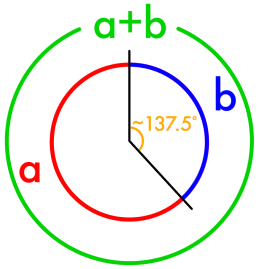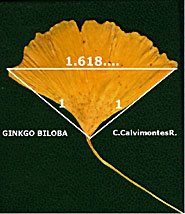The Fibonacci Sequence in Leaves
The Fibonacci sequence is present in both the structure and arrangement of leaves in many plants. Since plants rely on photosynthesis, they want to maximize the amount of sunlight that strikes their leaves. The vertical growth of many plants means that leaves can cover up each other. To minimize this effect, the leaves are grown such that the angle between each successive leaf is the golden angle, as shown in Figure 2.


The golden angle is simply the golden ratio applied to a circle: it is the smaller angle formed by two arcs that are related by the golden ratio.
This angle minimizes the amount of overlap between the layers of leaves, maximizing the amount of sunlight the plan can receive (12). One method of seeing why this is the case is to consider the graph $ y = \frac{1}{\phi} x $, plotted in Figure 3.

Since the golden ratio is irrational, it will never intersect any of the points on the grid, which represent integer pairs. In fact, this line will miss the grid points better than a line with any other slope; in some sense it is the “most irrational” number. To understand why, it is useful to consider the definition of an irrational number, and how the golden ratio can be related to this definition.
An irrational number is one which cannot be expressed by a fraction. One way of considering the meaning of the "most irrational" number is to find a number that is the hardest to approximate with a fraction. For example, pi, while irrational, is fairly well approximated by $ \frac{22}{7} $. To more closely study the process of approximating irrationals, it is useful to look at continued fractions. The best way to explain a continued fraction is via an example. Consider the continued fraction for $ \sqrt{2} $:
Thus progressing by multiples of the golden ratio is the best choice to avoid nearing integers. Since the number of plant leaves must be an integer, arranging them using the golden ratio minimizes their overlap. This concept is discussed in more depth in "The Golden Ratio (why it is so irrational)" on the YouTube channel Numberphile.
Often the leaves themselves can be related to the Fibonacci sequence. For example, the veins of some leaves are roughly spaced by the golden ratio. The leaves of the Ginko Tree also have been found to grow with dimensions that include the golden ratio (11). Examples of these phenomena are shown in Figures 4 and 5.



